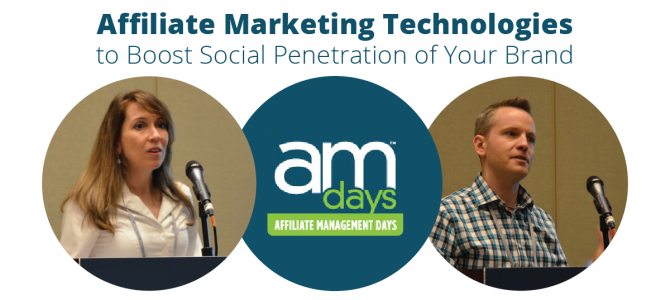Affiliate Management Days (AM Days) kicked of at 7:30am prompt in beautiful downtown San Francisco with an agenda chock-full of sessions from some of the affiliate marketing industry’s most influential thought leaders. Among this list of speakers was LinkConnector’s Vice President of Sales and Marketing, Tara McCommons, who presented a case study with Nick Andrews of ReviTrage, on Affiliate Marketing Technologies to Boost Social Penetration of Your Brand.
Tara gave insight into three different technologies that empower advertisers to enter the social space, thus opening the door to more traffic and more conversions from an otherwise under-utilized population of social media affiliates—of whom trigger 6-times more traffic and 2-times more conversions when sharing a brand’s content on their social channels. She pointed out that these affiliates’ success is based on the success of the advertiser, and are therefore highly invested in the brands they choose to promote.
Tara showed an image of golden goose egg to illustrate the importance of nurturing the affiliate relationships that are successful—referring to them as “the golden goose affiliates”. Nurturing these affiliate relationships means providing them with the right tools to empower their social media promotional efforts. Following are three of the must-have technologies:
1. Adaptive Attribution
Why is it important? One in three U.S. consumers are influenced by social media in their purchases—social affiliates influence each step of the purchase journey, so it is essential to ensure your program is setup to reward their efforts throughout this journey.
Helpful Resource: The Performance Marketing Association’s (PMA) whitepaper provides an overview of attribution tools and techniques within the affiliate marketing industry: http://thepma.org/resources/project/attribution-insights-2015/
2. Coupon Code Attribution
Why is it important? Tracking without a click is possible! Naked Coupons empower any type of affiliate to evolve their promotion with no click and no cookie required allowing affiliates to reach potential customers in new ways such as emojis, Instagram, Twitter, TV broadcasting, billboards, niche conferences, etc.
Important Stat: Depending on an LC affiliate’s promotional type, up to 40% of the time, conversions would not be possible without naked coupons.
As Tara concluded her slides on Coupon Code Attribution, Nick took the podium to present a few eye-opening numbers, strongly supporting the effectiveness of Naked Coupons. He used ThredUp to give a detailed review of the changes this advertiser saw in a six-month period using naked coupons, reporting an increase of 30,000 code-views within three weeks of the launch date and $60,000 in new customer revenues within the first six months. Nick provided an additional overview of ReviTrage’s success stories including clients such as Extended Stay America, Jelly Bean, FanDuel and GoDaddy.com.
Once Nick concluded his slides, he handed the microphone back to Tara to wrap up the presentation with a third and final technology to boost social penetration for brands.
3. Cross Device & Browser Tracking
Why is it important? Four in ten purchases occur across multiple devices or channels. Ensure your program supports cross device and browser tracking to properly attribute affiliate revenue in this ever-growing, multi-device era.
Important Stat: 37% of desktop buyers browsed the same retailer’s site on at least one other device before purchasing.
Highlight from the Q&A
Question: Could this form of coupon code attribution be considered cannibalism in the coupon space or is it really adding true value?
Answer: Social affiliates introduce new customers to retailers that otherwise wouldn’t have lead to a purchase on the retailer’s website. Social affiliates have the ability to reach the consumers who weren’t on an advertiser’s site and weren’t even thinking about making a purchase. For example, a consumer sees a coupon code for Jelly Belly on twitter because they searched #EasterCandy. They then decide to take that code and use it to make a purchase they wouldn’t have otherwise made.
Feature image provided by @Tim_Ash.

